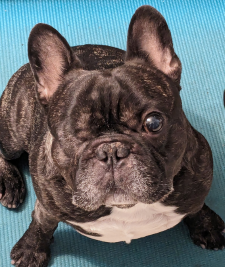How can you help your dog recover from trauma, either physical or life-changes? If we could keep our dogs’ lives happy, peaceful, and pain-free, all of us would. We love our dogs and never want anything bad to happen.
Unfortunately, as we all know, that’s not how life works. Despite our best efforts, a bad thing happen to good dogs. It’s up to us to minimize the effects of any kind of trauma to help them move on.
Coping with calamity
Dogs, for the most part, live in the moment. If they’re happy and comfortable now, yesterday might as well never have happened. If yesterday was traumatic, the best thing you can do is make today normal.
We are, sadly, all too familiar with life-disrupting awfulness. If you’ve been following us for a while, you know that Torque, Hope’s nine-year-old French Bulldog, had to have emergency surgery to remove his eye last New Year’s Eve. There’s not a whole lot that gets the adrenaline pumping faster than a medical emergency on a holiday.
You would think there was time to breathe once Torque was in the hands of the veterinary ophthalmologist. There wasn’t. Four hours later, he was back home, drugged to the sky. The other dogs knew something was happening and they were restless and upset.
What now?
We did the absolute best thing we could think of. As soon as everyone was back home, we set the regular Sunday evening routine in motion. There may have been an extra adult beverage for the humans. But the dogs went out on schedule, played training games when they usually do, ate on schedule, and settled in for their regular evening cuddles.
There is nothing more comforting to dogs than knowing what’s going on. When everyone is where they should be and the established routine is in effect. Dogs can cope with just about anything when surrounded by the familiar.
Don’t make it special
A woman we know is coping with the sudden, unexpected loss of her young male dog. His death was unexpected and sudden. Her older, female dog is also coping with the loss of her buddy.
This person was lost and the hole in her life needed to be filled. Within a month, she took her girl and hit the road to pick up her new little “brother.”
The new dog isn’t a puppy. It is the same breed, and a boy, like the dog they lost. But other than that, everything is different.
The wise move would have been, as soon as they got home, to restart familiar schedules, patterns, and routines. They had regular, weekly Rally Obedience training sessions with Fran. Getting back on track would settle the older girl and let her know the new normal is still okay.
Instead, this person is taking time off, thinking that more time will help the dogs adjust. That thinking applies better to people than dogs.
Get back to the grind
The best thing you can do to help your dog recover from either physical or emotional trauma is pretend everything’s okay. Return to a normal schedule, do the things you regularly did. Don’t let your dog know you’re as traumatized as they are. You have to be the steadying presence for your dog, even if you’re not feeling it. In the words of a prophet – fake it ‘til you make it.
Enjoyed this post? Click here to sign up for the weekly newsletter and never miss another.


















